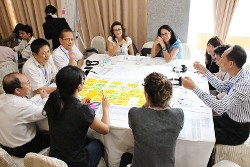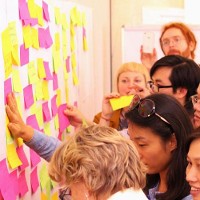11 November 2014
From story to science
IIASA stakeholders include farmers in Africa, Asia, and South America affected by climate change; EU officials and international governments developing air pollution and climate policies; and world leaders at the top levels of global decision‑making, including United Nations processes on climate change and sustainable development.
"A stakeholder can be anyone with an interest, concern, or knowledge about an issue,” says Joanne Bayer, director of IIASA’s Risk, Policy and Vulnerability Program, “At its most basic level, ‘stakeholder consultation’ just means going to people to get information that can inform research.” But today, the term means far more: intimate and innovative processes that engage stakeholders in model development and policy formation, not just informing research, but also ensuring that the people involved have ownership of the science.
The people behind the models
Much IIASA research relies on complex models that can explore future changes across multiple linked areas. Researchers use these models to produce scenarios that can project how different policy choices may lead to different future developments. For example, the Global Biosphere Management Model (GLOBIOM) is used to analyze competition between agriculture, bioenergy, and forestry in land use.
GLOBIOM researchers talk to stakeholders to understand what factors drive land use change, and how. But to put these drivers in their model, scientists need numbers, while the farmers and policymakers they work with rarely think in terms of spreadsheets, percentages, and plus and minus signs.
IIASA researcher Amanda Palazzo traveled to Nepal, Vietnam, Costa Rica, and Colombia in 2013 to help facilitate a series of scenario-building workshops as part of a project on food security, environment, and rural livelihoods for the Climate Change, Agriculture and Food Security (CCAFS) research program of the global agriculture consortium CGIAR.
During the workshops, Palazzo and her colleagues worked step‑by-step with the stakeholders to understand what factors they expect to influence future agriculture, working together to
develop the verbal descriptions into more quantitative indicators that could be fed into a model.
Following the workshop, the researchers then ran the model and came back with a set of scenarios for the stakeholders to discuss. Palazzo says, “We asked them if the scenarios looked credible, and why or why not, and then we went back to refine them.” When the quantitative modeling results did not fit the context of the region or the storylines, the group made changes, and then ran the model again, repeating until the scenarios seemed useful.
“Unique in this process was that we asked them not just about the factors they were sure about, but also to note things that are uncertain, but relevant to the future,” says Palazzo. “It is a lot of work, but it is worth it to know that we are not just pulling our scenarios for the future out of thin air.”
In another recent project funded by the European Commission, IIASA researcher Jan Sendzimir and colleagues in 16 countries explored the conceptual and practical challenges of linking stories to models, working with stakeholders with an interest in climate change and freshwater resources in Europe.
Wageningen University researcher Kasper Kok led the stakeholder interaction activities. He says, “The weakest link in connecting stories to models is turning the storyline into numbers. When you ask stakeholders to put a number on something, often they throw their arms up and say, ‘How am I supposed to know? You’re the expert.’”
So the researchers introduced a way to include uncertainty in their process, an approach known as Fuzzy Set Theory. “The reason it’s called ‘fuzzy’ is that we allow them to be uncertain,” says Kok. For example, when asked to define ‘low’ or ‘high’ rates of population growth, the stakeholders can provide an overlapping set of numbers as the definitions for low and high growth.

By involving stakeholders directly in research aimed at policy solutions, researchers gain more buy-in from the people who will implement and be affected by new policies. In the photos above, stakeholders from southeast Asia discuss climate adaptation during a workshop in Vietnam in November, 2013.
The goal of the project was for stakeholders to provide crucial inputs to a model that they could use themselves to examine the potential impacts of their choices. By involving them directly, said Kok, the stakeholders also had more ownership over the process and results. He says, “Sometimes stakeholder input gets a bit lost under all the descriptions of modeling efforts. But we take their involvement very seriously. We try to produce scenarios that are
authored by the stakeholders—not by the scientists.”
Agreeing to disagree
Another challenge with stakeholder consultation is that every person has a different worldview. “If you ask a group of engineers for a solution to retain water in a landscape, they’ll tell you to build a reservoir. Ask an environmentalist and they may argue for wetlands preservation,” says Bayer.
In a long-running research project focused on landslide risk in the Italian town of Nocera Inferiore, Bayer and her colleagues worked with local residents and decision makers to define a risk management policy. In 2005, a massive landslide decimated the town and killed three people. But nearly 10 years later, the community remains at a stalemate with how to prevent
such future catastrophes, because of public opposition to potential solutions.
The project took a new tack by encouraging the participants to maintain their own opinions and ideas, rather than push them to agree on a consensus. In that way, the researchers gathered a range of opinions and inputs and at the same time, allowed the participants to learn from each other.
“Our goal was to encourage compromise,” says Bayer. Sometimes, the researchers say, numbers are not the best representation of reality—and recognizing that can be key to
better science.
Sendzimir says, “We must push to obtain numbers that allow us to model, for that enables us to much more rigorously explore options. But in many cases, we are not modeling reality. We are modeling people’s perceptions, and if we really better understood the diversity of perceptions involved and their implications, that would be an excellent contribution to better decision making.”
Further information
Kok K, Bärlund I, Flörke M, Gramberger M, Holman I, Sendzimir J, Stuch B, Zellmer K. European participatory scenario development: Strengthening the link between stories and models. Climatic Change (Published online 3 June 2014) [doi:10.1007/s10584-014-1143-y].
Kok K, van Vliet M, Bärlund I, Dubel A, Sendzimir J (2011). Combining participative backcasting and exploratory scenario development: Experiences from the SCENES project. Technological Forecasting and Social Change 78(5):835–851 [doi:10.1016/j.techfore.2011.01.004].
Text by Katherine Leitzell
CONTACT DETAILS
Distinguished Emeritus Research Scholar Equity and Justice Research Group - Population and Just Societies Program
Research Scholar Integrated Biosphere Futures Research Group - Biodiversity and Natural Resources Program
Guest Research Scholar Equity and Justice Research Group - Population and Just Societies Program
Options Winter 2014/2015
Globiom
A global model to assess competition for land use between agriculture, bioenergy, and forestry


